L.A. keeps building near freeways, even though living there makes people sick
Are you one of the 2.5 million Southern Californians already living in the pollution zone?
By TONY BARBOZA AND JON SCHLEUSS
MARCH 2, 2017, 3 A.M.
1 dot = 1 person living within 1,000 feet of a freeway in 2010
For more than a decade, California air quality officials have warned against building homes within 500 feet of freeways.
And with good reason: People there suffer higher rates of asthma, heart attacks, strokes, lung cancer and pre-term births. Recent research has added more health risks to the list, including childhood obesity, autism and dementia.
Yet Southern California civic officials have flouted those warnings, allowing a surge in home building near traffic pollution, according to a Los Angeles Times analysis of U.S. Census data, building permits and other government records.
In Los Angeles alone officials have approved thousands of new homes within 1,000 feet of a freeway — even as they advised developers that this distance poses health concerns.
http://www.latimes.com/projects/la-me-freeway-pollution/#nt=notification
The city issued building permits for 4,300 homes near freeways in 2015 — more than in any year over the last decade — and signed off on an additional 3,000 units last year.
Public funds, including millions of dollars from California’s cap-and-trade program to cut greenhouse gas emissions, are going to developers to build new homes in freeway pollution hot spots.
The population near Los Angeles freeways is growing faster than elsewhere in the city as planners push developers to concentrate new housing near transportation hubs, convinced that increasing urban density will help meet state targets for greenhouse gas reductions.
More than 1.2 million people already live in high-pollution zones within 500 feet of a Southern California freeway, with more moving in every day. Between 2000 and 2010 — the most recent period available — the population within 500 feet of a Los Angeles freeway grew 3.9%, compared with a rate of 2.6% citywide.
Orsini
1,072-unit apartment complexOpened in three phases between 2004 and 2010
1-bedroom apartment rents for $2,000 to $2,500 a month
Developer Geoffrey H. Palmer has built thousands of units near downtown L.A. freeways and plans more
Have you ever lived near a freeway? Tell us your story
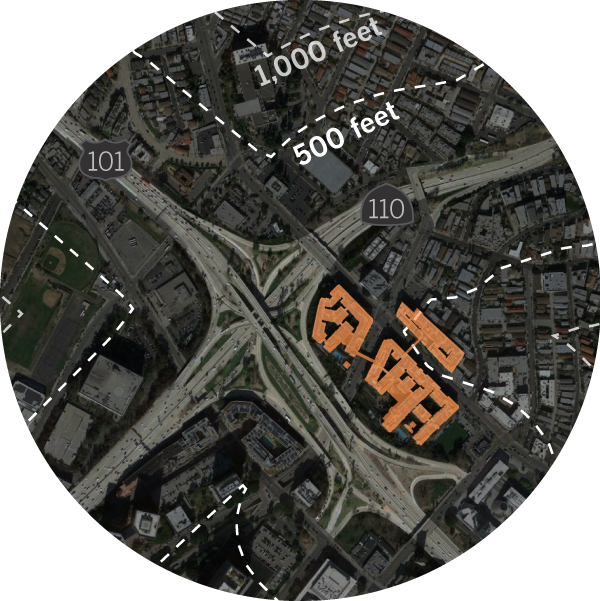
Los Angeles City Councilman José Huizar, who lives several hundred feet from Interstate 5, said freeway pollution is such an urgent and complex problem that he wants the city to establish buffer zones. He called for a “comprehensive, citywide study of development near freeways that would analyze all impacts of limiting development around freeways.”
Other elected officials and business groups argue that Los Angeles is so thoroughly crisscrossed by freeways that restricting growth near them is impractical and would hamper efforts to ease a severe housing shortage. In some cases, city officials are paving the way by re-zoning industrial land along freeways and other transportation corridors.
In an interview at a recent groundbreaking for a freeway-adjacent apartment project, Los Angeles Mayor Eric Garcetti said that he grew up near the 101 and 405 freeways and that many in his family had cancer.
But he said he opposes any restrictions on how many homes can be built near freeways and thinks that improving air-filtration, building design and tailpipe emissions are a better way to reduce risks to residents.
“I take this stuff very seriously, but I also know that in looking for housing we have a very constricted city,” he said.
Garcetti spokesman Carl Marziali noted that a prohibition on building within 1,000 feet of freeways, for example, would cover more than 10% of land currently zoned for residential construction in the city, from Westwood to Boyle Heights and San Pedro to Sherman Oaks. But proponents of stricter planning, including supporters of Measure S, a proposal on the March 7 ballot that would place new restrictions on development, have criticized city officials for approving what they term “black lung lofts.”
How close to the freeway are you?
Low rent and a location near shops and restaurants are what brought Jeremiah Caleb to an apartment on Beloit Avenue, where a sound wall is all that separates the 405 freeway from sleek new apartments and lofts advertising “good living.”
But life got worse for Jeremiah and his wife Angel soon after moving into that one-bedroom on the Westside of Los Angeles.
The couple began to struggle with bouts of coughing, sneezing and headaches. They kept the windows shut, yet a grimy, black film settled regularly over the furniture, counters and even their skin — a never-ending reminder of the vehicle exhaust and soot they were breathing just 100 feet from 14 lanes of traffic.
“We were constantly sick,” said Caleb, an actor in his 30s. The couple worried enough about dirty air that they put off having children. “We were desperate to leave, but we felt stuck. We just couldn't afford it.”
Business groups have consistently opposed any suggestion of restricting development near heavy traffic.
“Freeways are part of Los Angeles' fabric and prohibiting housing by them is unrealistic,” said Carol Schatz, president of the Downtown Center Business Improvement District. She argues that such restrictions would worsen the housing crisis and severely limit the ability to build housing near mass transit.
The Southern California Assn. of Governments, the regional planning agency for Los Angeles, Ventura, Orange, Riverside, San Bernardino and Imperial counties, has projected that the population within 500 feet of a freeway will increase by a quarter million people by 2035.
Rob McConnell, a professor of preventive medicine at USC who studies roadway pollution, is one of a number of health researchers who has advised city officials not to allow new housing that close to freeways.
“I tell them you’re going to make a lot of people sick,” McConnell said.
Scientists have long known that polluted air cuts lives short.
But pinpointing the harmful agents in traffic pollution is difficult because it’s a stew of ingredients including toxic combustion gases, microscopic soot particles, compounds from worn tires and dust from vehicle brake pads. Recent research has narrowed in on one component of special concern: ultra-fine particles, pollutants in freshly emitted vehicle exhaust that can be five to 10 times higher near traffic.
The invisible, chemical-laden specks are less than one-thousandth the width of a human hair — so tiny they are hard to capture with pollution controls or filters. Scientists suspect ultra-fine particles are able to pass through the lungs and into the bloodstream, where they may harm the heart, brain and other organs. Yet they remain unregulated by state and federal authorities.
That emerging science has raised concerns that decades of government regulations, aimed at curbing smog that builds up across vast urban areas, are not sufficiently tailored to the more localized problem of roadway pollution.
Two years ago, state environmental officials concluded that diesel soot and other carcinogens in vehicle exhaust pose nearly three times the cancer risk previously thought.
In a long-term study, USC researchers have for more than two decades measured the lung capacity of thousands of school children across Southern California. They found that children growing up near major roadways have higher rates of asthma and other respiratory illnesses, including deficits in lung function that can be permanent and lead to a lifetime of health problems.
Even in communities with cleaner air, such as Santa Maria near the Santa Barbara County coast, children living near traffic had the same lung function loss as those in Riverside and other smoggy inland areas, the scientists found.
Anthony Moretti, chairman of pediatrics at White Memorial Medical Center in Boyle Heights, said children who live close to freeways are among those who most frequently land in the emergency room struggling to breathe and in need of treatment for asthma and other respiratory diseases.
“These kids will come in four, five, six times over a six-month period, and clearly their environment is a factor,” he said. "I feel for these families because they suffer an undue burden of illness simply because of where they live.“
Public health officials have long warned that traffic pollution can drift well over 1,000 feet from traffic — and more recent research suggests that it may waft more than a mile.
Yet it took lawsuits and a nationwide mandate from the U.S. Environmental Protection Agency to force Southern California air quality officials to begin regularly measuring pollution near Southern California freeways in 2014.
The first readings confirmed that people near freeways breathe higher levels of the exhaust gases nitrogen dioxide and carbon monoxide. Then, in 2015, the South Coast Air Quality Management District detected the region’s highest concentrations of fine particulate matter at a new monitoring station 30 feet from the 60 Freeway in Ontario. The findings added compelling evidence that traffic emissions are piling on top of regional smog, hitting people near freeways with a double dose of pollution.
To learn more about the problem, The Times conducted air quality testing at sites where new housing is planned near Los Angeles freeways.
In August and September of 2015, reporters collected air samples at several locations using portable pollution sensors that detect ultra-fine particles, the microscopic pollutants in vehicle exhaust. One set of air samples was taken next to stretches of the 110 and 5 freeways and another set was taken 1,500 to 1,800 feet from the freeways.
Ultrafine particles spike near freeways
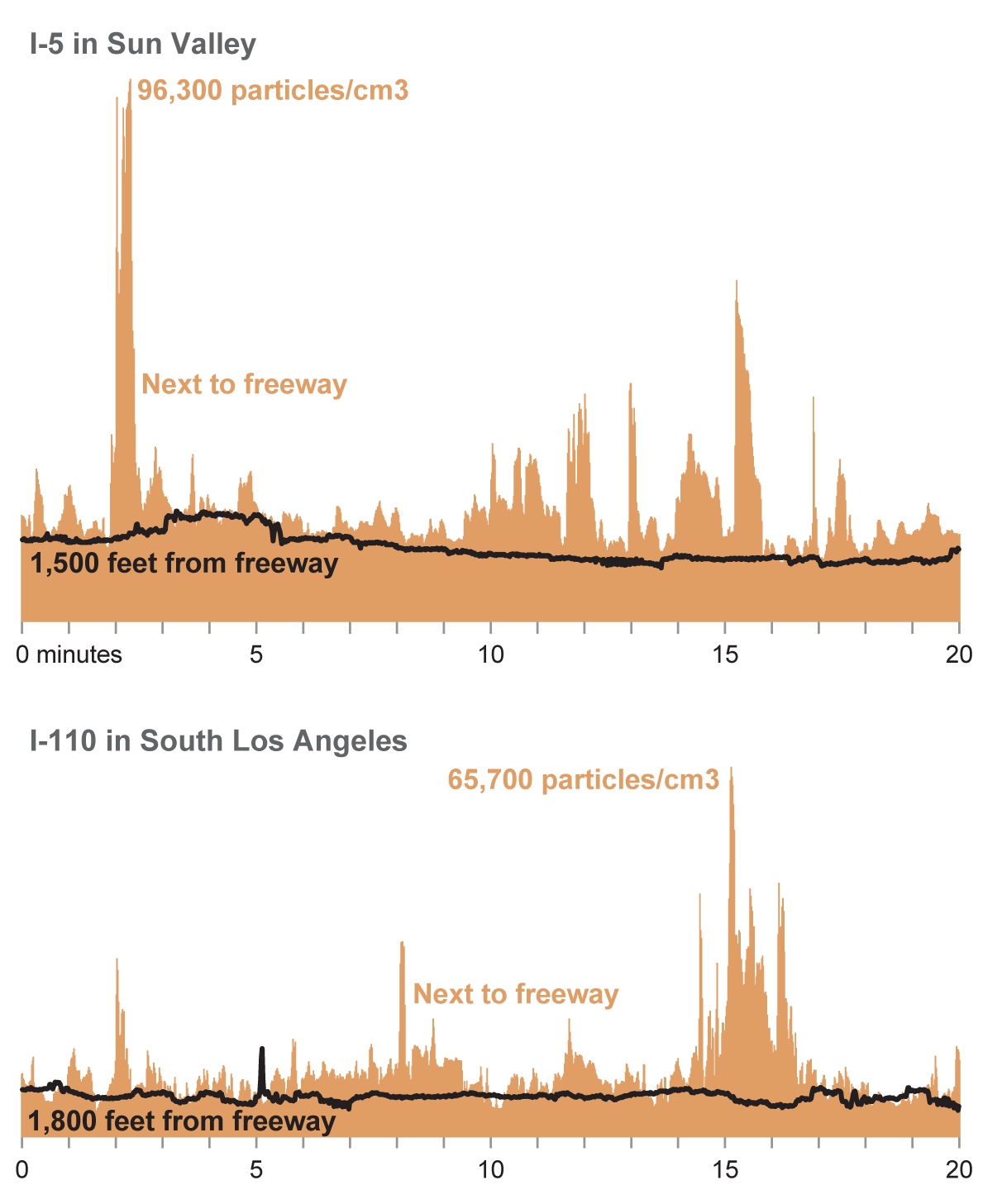
Source: TSI P-Trak Ultrafine Particle Counter 8525 readings on Aug. 20, 2015 and Sept. 24, 2015. See the data
Pollution readings near the freeways were three to four times higher than in neighborhoods at a distance from traffic. Diesel trucks produced the most noticeable pollution, coughing out foul plumes of exhaust and soot that could be seen and smelled as pollution readings jumped.
Scientists at USC and the South Coast air district said the readings were consistent with their measurements near freeways.
One of the locations where reporters detected high pollution levels was next to a vacant lot along the 110 Freeway in South Los Angeles where two apartment buildings for low-income residents are being built.
The $55-million Meta Housing Corp. project, which will bring 160 new housing units to the busy traffic corridor, is partly funded with money from pollution permits sold under the state’s cap-and-trade program, among other state and local government subsidies.
Among the most visible and controversial projects that have raised traffic pollution concerns in Los Angeles are developer Geoffrey H. Palmer’s massive Italianate apartment complexes overlooking downtown freeways. He has built thousands of units and is planning more.
In interviews, current and past residents of Palmer’s Orsini development, which hulks over the interchange of the 101 and 110 freeways, said they moved to the complex for its convenient downtown location. But many spoke of keeping windows closed to block noise and pollution, deploying house plants to soak up the bad air and constantly sweeping and dusting the fine black soot that seems to find its way onto every surface.
Felicia Gargani said her pet peeve was the grime that collected on her fourth-floor balcony that looked out over the freeway. “If you walk out there barefoot,” she said, “your feet turn black."
Construction on the Orsini began more than a decade ago, before scientists grasped the extent of the health hazards of building so close to traffic.
In the years since, the South Coast air district has sent dozens of letters to cities sounding alarms about similarly risky home building proposals near freeways in Los Angeles and other communities across its four-county jurisdiction.
Approved in 2013 by the L.A. City Council over the objections of air quality officials
Developer M. David Paul pledged to use enhanced air filters Tell us your freeway story
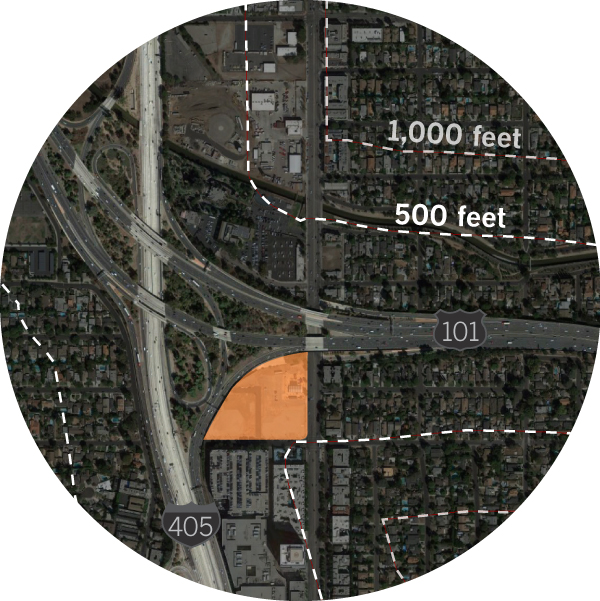
The air-quality agency reserved some of its strongest criticisms for developer M. David Paul’s 325-unit Il Villaggio Toscano project proposed near the 405-101 interchange in Sherman Oaks, urging Los Angeles city planners in 2011 to “reconsider placing new housing immediately adjacent to one of the busiest freeway intersections in Southern California.”
The city “is ignoring the abundant health science data that has come out over the past decade that demonstrates serious health consequences for those living near a freeway,” the air district’s Ian MacMillan wrote.
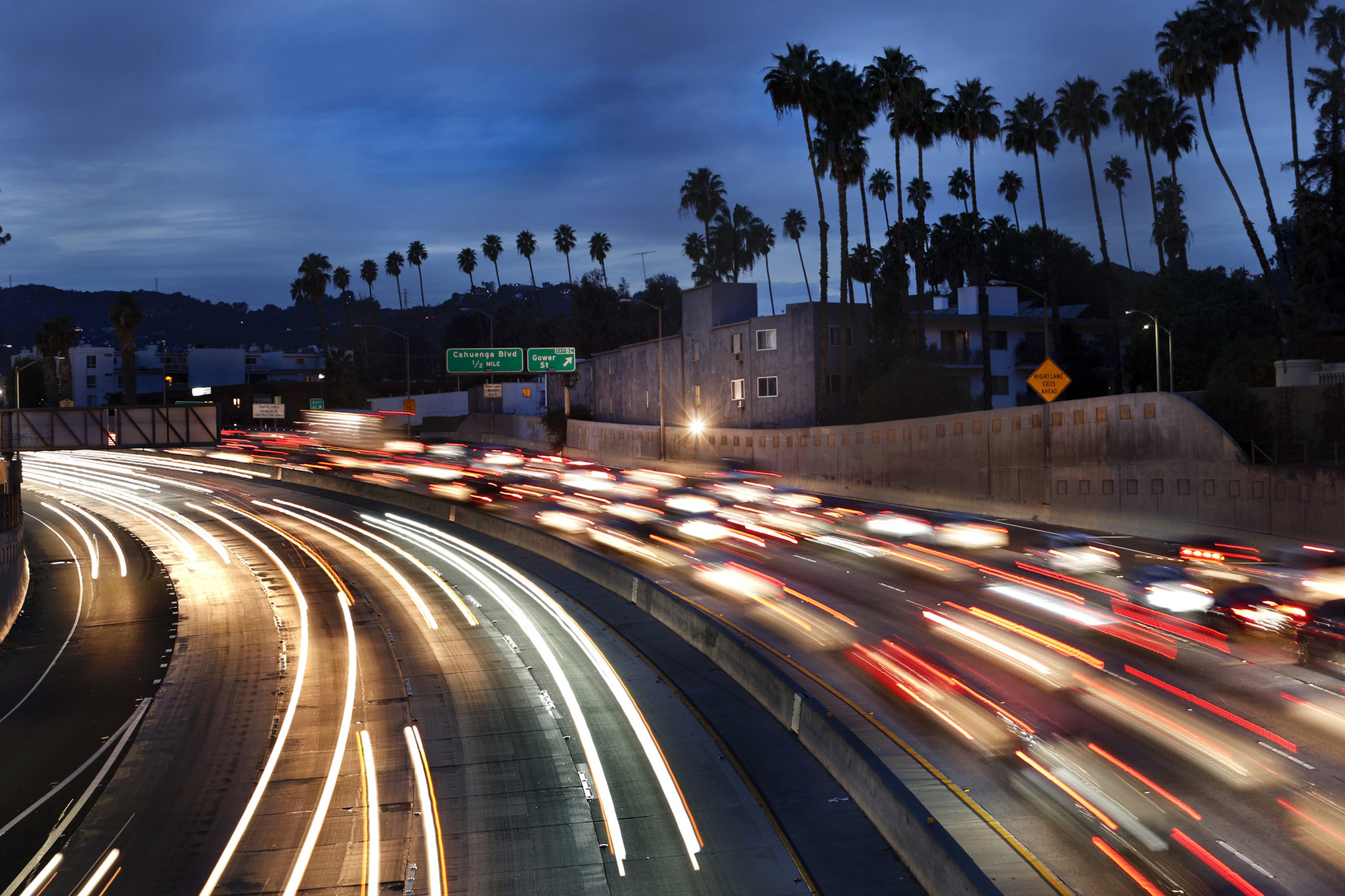 Motorists travel along the 101 Freeway in Hollywood. (Mel Melcon / Los Angeles Times) View more photos
Motorists travel along the 101 Freeway in Hollywood. (Mel Melcon / Los Angeles Times) View more photos 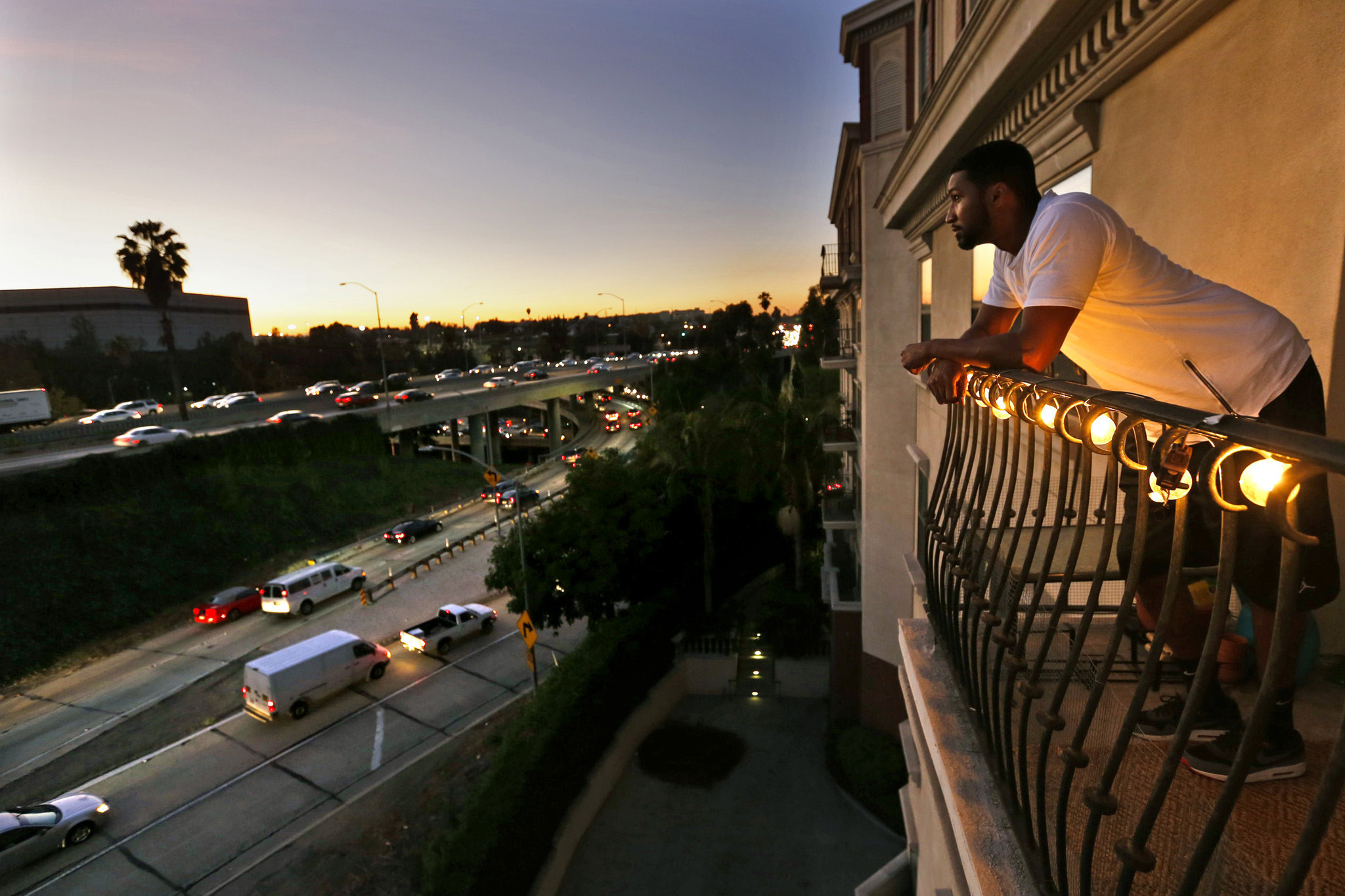 Everett Smith, a renter at the Orsini apartments, looks out from his balcony at rush hour traffic on the 101 and 110 freeway interchange in downtown Los Angeles. (Don Bartletti / Los Angeles Times)
Everett Smith, a renter at the Orsini apartments, looks out from his balcony at rush hour traffic on the 101 and 110 freeway interchange in downtown Los Angeles. (Don Bartletti / Los Angeles Times)
The City Council approved the project unanimously in August 2013, with its backers pledging to use the highest-rated air filters.
Los Angeles officials now require all homes built near freeways to have air filtration systems that rate at least 13 on the industry’s 16-point effectiveness scale.
California air regulators acknowledge that decades of strict vehicle emissions standards have slashed tailpipe emissions, and they say air quality along freeways will continue to improve as the state transitions to cleaner vehicles and fuels.
Health officials say that those mitigating steps are good, but that the only way to solve the problem is for city and county officials to stop residential building near freeways.
And that, say legal experts, is well within their authority.
Planning experts cite a number of possible approaches to the public health problem.
Cities could re-zone areas near heavy traffic to exclude new residential development or change their general plans to prohibit such uses, planning experts say. Officials could adopt ordinances or moratoriums on new residential development. Or they could strengthen building standards — as they have for seismic reasons — forcing developers to design buildings in a way that reduces residents’ exposure to polluted air.
“If there's a political will to protect people from this type of development then cities certainly know how to use zoning to accomplish that,” said James Kushner, an expert in land-use, development and urban planning at Southwestern Law School.
Thousands of homes approved near L.A. freeways
Use the slider to see where the city has issued building permits within a 1,000 feet of a freeway since 2005.
2005
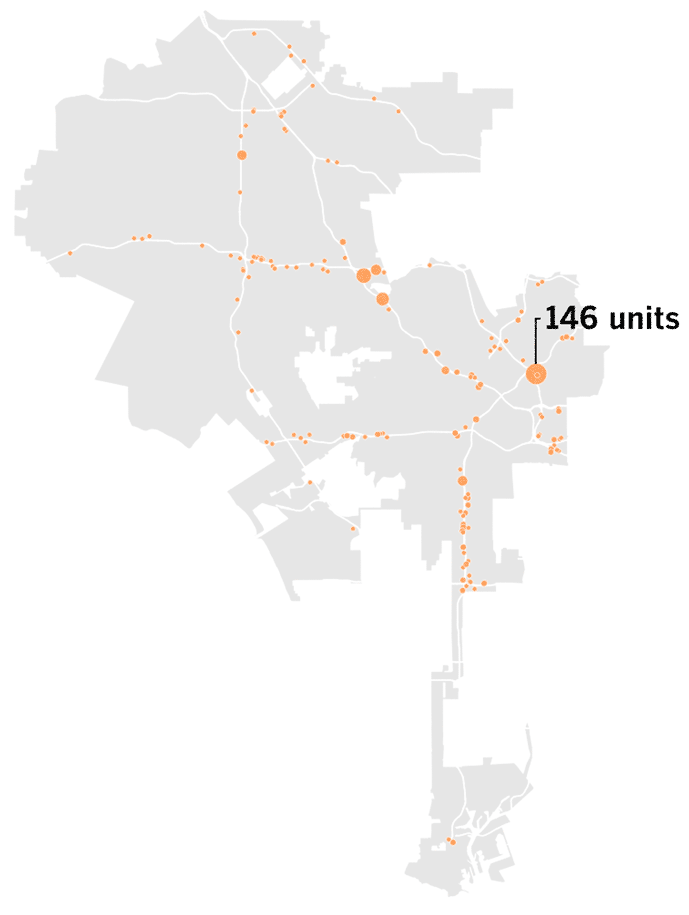 S
S
Pollution readings near the freeways were three to four times higher than in neighborhoods at a distance from traffic. Diesel trucks produced the most noticeable pollution, coughing out foul plumes of exhaust and soot that could be seen and smelled as pollution readings jumped.
Scientists at USC and the South Coast air district said the readings were consistent with their measurements near freeways.
One of the locations where reporters detected high pollution levels was next to a vacant lot along the 110 Freeway in South Los Angeles where two apartment buildings for low-income residents are being built.
The $55-million Meta Housing Corp. project, which will bring 160 new housing units to the busy traffic corridor, is partly funded with money from pollution permits sold under the state’s cap-and-trade program, among other state and local government subsidies.
Among the most visible and controversial projects that have raised traffic pollution concerns in Los Angeles are developer Geoffrey H. Palmer’s massive Italianate apartment complexes overlooking downtown freeways. He has built thousands of units and is planning more.
In interviews, current and past residents of Palmer’s Orsini development, which hulks over the interchange of the 101 and 110 freeways, said they moved to the complex for its convenient downtown location. But many spoke of keeping windows closed to block noise and pollution, deploying house plants to soak up the bad air and constantly sweeping and dusting the fine black soot that seems to find its way onto every surface.
Felicia Gargani said her pet peeve was the grime that collected on her fourth-floor balcony that looked out over the freeway. “If you walk out there barefoot,” she said, “your feet turn black."
Construction on the Orsini began more than a decade ago, before scientists grasped the extent of the health hazards of building so close to traffic.
In the years since, the South Coast air district has sent dozens of letters to cities sounding alarms about similarly risky home building proposals near freeways in Los Angeles and other communities across its four-county jurisdiction.
Il Villaggio Toscano
Planned 325-unit apartment complexApproved in 2013 by the L.A. City Council over the objections of air quality officials
Developer M. David Paul pledged to use enhanced air filters Tell us your freeway story

The air-quality agency reserved some of its strongest criticisms for developer M. David Paul’s 325-unit Il Villaggio Toscano project proposed near the 405-101 interchange in Sherman Oaks, urging Los Angeles city planners in 2011 to “reconsider placing new housing immediately adjacent to one of the busiest freeway intersections in Southern California.”
The city “is ignoring the abundant health science data that has come out over the past decade that demonstrates serious health consequences for those living near a freeway,” the air district’s Ian MacMillan wrote.
 Everett Smith, a renter at the Orsini apartments, looks out from his balcony at rush hour traffic on the 101 and 110 freeway interchange in downtown Los Angeles. (Don Bartletti / Los Angeles Times)
Everett Smith, a renter at the Orsini apartments, looks out from his balcony at rush hour traffic on the 101 and 110 freeway interchange in downtown Los Angeles. (Don Bartletti / Los Angeles Times)The City Council approved the project unanimously in August 2013, with its backers pledging to use the highest-rated air filters.
Los Angeles officials now require all homes built near freeways to have air filtration systems that rate at least 13 on the industry’s 16-point effectiveness scale.
California air regulators acknowledge that decades of strict vehicle emissions standards have slashed tailpipe emissions, and they say air quality along freeways will continue to improve as the state transitions to cleaner vehicles and fuels.
Health officials say that those mitigating steps are good, but that the only way to solve the problem is for city and county officials to stop residential building near freeways.
And that, say legal experts, is well within their authority.
Planning experts cite a number of possible approaches to the public health problem.
Cities could re-zone areas near heavy traffic to exclude new residential development or change their general plans to prohibit such uses, planning experts say. Officials could adopt ordinances or moratoriums on new residential development. Or they could strengthen building standards — as they have for seismic reasons — forcing developers to design buildings in a way that reduces residents’ exposure to polluted air.
“If there's a political will to protect people from this type of development then cities certainly know how to use zoning to accomplish that,” said James Kushner, an expert in land-use, development and urban planning at Southwestern Law School.
Thousands of homes approved near L.A. freeways
Use the slider to see where the city has issued building permits within a 1,000 feet of a freeway since 2005.
2005
 S
S
ources: Los Angeles Department of Building and Safety, L.A. County Assessor, OpenStreetMap See the data
One of the only attempts at a ban on development occurred several years ago when the L.A. County Department of Public Health proposed language in the county’s general plan to prohibit new housing within 500 feet of freeways, citing the adverse health effects. County planners ultimately rejected the idea.
The failure of such restrictions to gain traction has left some local officials wondering if the only way to keep cities from building more homes near freeways is through a state law.
One precedent is a 2003 law California passed prohibiting the construction of new public schools within 500 feet of freeways out of concern for children’s health. But school districts have used exceptions in the law to keep building.
Meanwhile, the residential developments that are rising next to freeways continue to spread not just through the urban core, but across the region.
One of those new neighborhoods is Cedar Point, a subdivision of one and two-story houses in the San Bernardino County suburb of Chino. The development was built on land that had been re-zoned for housing in a special election paid for by a real estate company. It sits about 100 feet from the 60 Freeway.
More than 220,000 vehicles motor by each day on this major freight corridor, including some 27,000 big-rig trucks whose diesel engines cough out many times more harmful pollutants than cars.
In January 2015, the South Coast air district sent a letter to Chino officials warning that freeway pollutants would threaten the health of residents in the new homes.
A few months later, the building site swarmed with construction workers and heavy equipment.
Dennis Yates, former mayor of Chino who served more than 12 years on the region’s air quality board, said that as mayor he encouraged the developer to put in higher-rated air filters, but acknowledged he “personally wouldn’t live there.”
Cedar Point
84 single-family homes in San Bernardino County suburb of Chino
Built in 2015 along one of California’s busiest diesel truck corridors
4-bedroom houses by Frontier Communities sell for around $600,000 Tell us your story
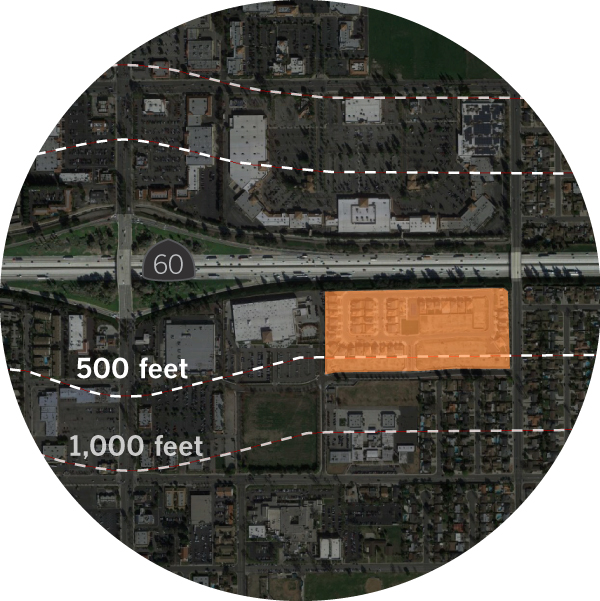
Among those who did move into one of Cedar Point's four-bedroom houses was Mike Sanchez, his wife and two young daughters.
Buying so close to traffic was a difficult decision, he said, but “one of the sacrifices we made to get into a new home.”
Back on the Westside of Los Angeles, Jeremiah Caleb, who spent years battling black road dust and illness while living in an apartment next to the 405, said he and his wife were relieved when she landed a nursing job — a second income that allowed them to move to a less-polluted neighborhood about a mile from any freeway.
Their health has improved, with their once-constant headaches and respiratory problems now a rarity.
“I can leave my doors open and I'm breathing fresh air all the time,” he said. “We got lucky. But for most people . . . They're stuck because that's what they can afford.”
One of the only attempts at a ban on development occurred several years ago when the L.A. County Department of Public Health proposed language in the county’s general plan to prohibit new housing within 500 feet of freeways, citing the adverse health effects. County planners ultimately rejected the idea.
The failure of such restrictions to gain traction has left some local officials wondering if the only way to keep cities from building more homes near freeways is through a state law.
One precedent is a 2003 law California passed prohibiting the construction of new public schools within 500 feet of freeways out of concern for children’s health. But school districts have used exceptions in the law to keep building.
Meanwhile, the residential developments that are rising next to freeways continue to spread not just through the urban core, but across the region.
One of those new neighborhoods is Cedar Point, a subdivision of one and two-story houses in the San Bernardino County suburb of Chino. The development was built on land that had been re-zoned for housing in a special election paid for by a real estate company. It sits about 100 feet from the 60 Freeway.
More than 220,000 vehicles motor by each day on this major freight corridor, including some 27,000 big-rig trucks whose diesel engines cough out many times more harmful pollutants than cars.
In January 2015, the South Coast air district sent a letter to Chino officials warning that freeway pollutants would threaten the health of residents in the new homes.
A few months later, the building site swarmed with construction workers and heavy equipment.
Dennis Yates, former mayor of Chino who served more than 12 years on the region’s air quality board, said that as mayor he encouraged the developer to put in higher-rated air filters, but acknowledged he “personally wouldn’t live there.”
Cedar Point
84 single-family homes in San Bernardino County suburb of Chino
Built in 2015 along one of California’s busiest diesel truck corridors
4-bedroom houses by Frontier Communities sell for around $600,000 Tell us your story

Among those who did move into one of Cedar Point's four-bedroom houses was Mike Sanchez, his wife and two young daughters.
Buying so close to traffic was a difficult decision, he said, but “one of the sacrifices we made to get into a new home.”
Back on the Westside of Los Angeles, Jeremiah Caleb, who spent years battling black road dust and illness while living in an apartment next to the 405, said he and his wife were relieved when she landed a nursing job — a second income that allowed them to move to a less-polluted neighborhood about a mile from any freeway.
Their health has improved, with their once-constant headaches and respiratory problems now a rarity.
“I can leave my doors open and I'm breathing fresh air all the time,” he said. “We got lucky. But for most people . . . They're stuck because that's what they can afford.”
No comments:
Post a Comment